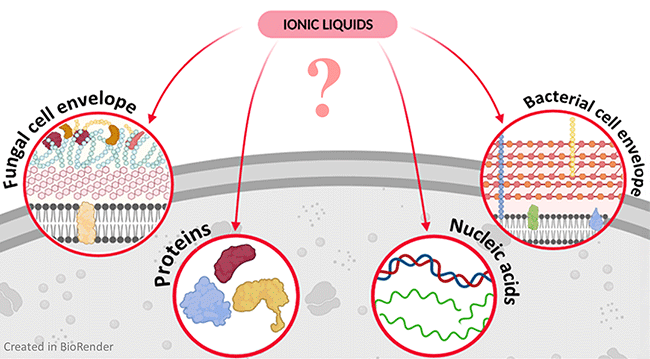RaCeDeLys: Untersuchung der Interaktion von ionischen Flüssigkeiten mit Zellhüllen, Proteinen und Nukleinsäuren von Pilz- und Bakterienzellen
In recent years, molecular diagnostics of health-relevant microorganisms has increasingly relied on the detection and quantification of their nucleic acids (NAs), DNA and RNA. The extraction of NAs from clinical or environmental samples is a necessary preparatory step to enable NA-based testing.
DNA/RNA extraction is a complex and laborious process for many target organisms, which must also be adapted to different sample types. Extraction often takes several hours and requires expensive equipment or hazardous chemicals, and is therefore considered a major bottleneck in molecular diagnostic workflows. In recent years, ionic liquids (ILs), salts with a melting temperature below 100°C, have become established as environmentally friendly solvents.
ILs can efficiently dissolve biomass (cellulose, lignin, chitin) and have been successfully used for the extraction of plant compounds, proteins and cells. They have also been found to stabilise DNA and small RNAs and to denature and reconstitute proteins.
Our group recently demonstrated that hydrophilic ILs can rapidly and effectively lyse plant, animal and bacterial cells, demonstrating the potential of ILs for NA extraction in molecular diagnostics. However, the mechanisms of IL interaction with the microbial cell wall leading to cell lysis and the effects of ILs on cell lysate components such as DNA, RNA and proteins are not yet fully understood. For fungal cells, IL-based cell lysis has not even been attempted yet.
In this project, we aim to identify hydrophilic ILs that are capable of lysing fungal and bacterial cells and to elucidate the nature of their interaction. First, we will investigate the interaction of hydrophilic ILs with the components of the microbial cell wall that leads to cell lysis. In addition, we aim to elucidate how ILs stabilise DNA and RNA and interact with proteins that are relevant for molecular diagnostics (nucleases, polymerases). This understanding of the interaction of hydrophilic ILs with cell wall components could enable the tailor-made design of ILs for the rapid and quantitative extraction of NAs from a wide range of target organisms in the future.
Furthermore, an understanding of the interaction of ILs with NAs, nucleases and polymerases and their influence on down-stream reactions such as hybridisation, PCR or sequencing is essential for the selection of ILs to be used in molecular diagnostic workflows.


